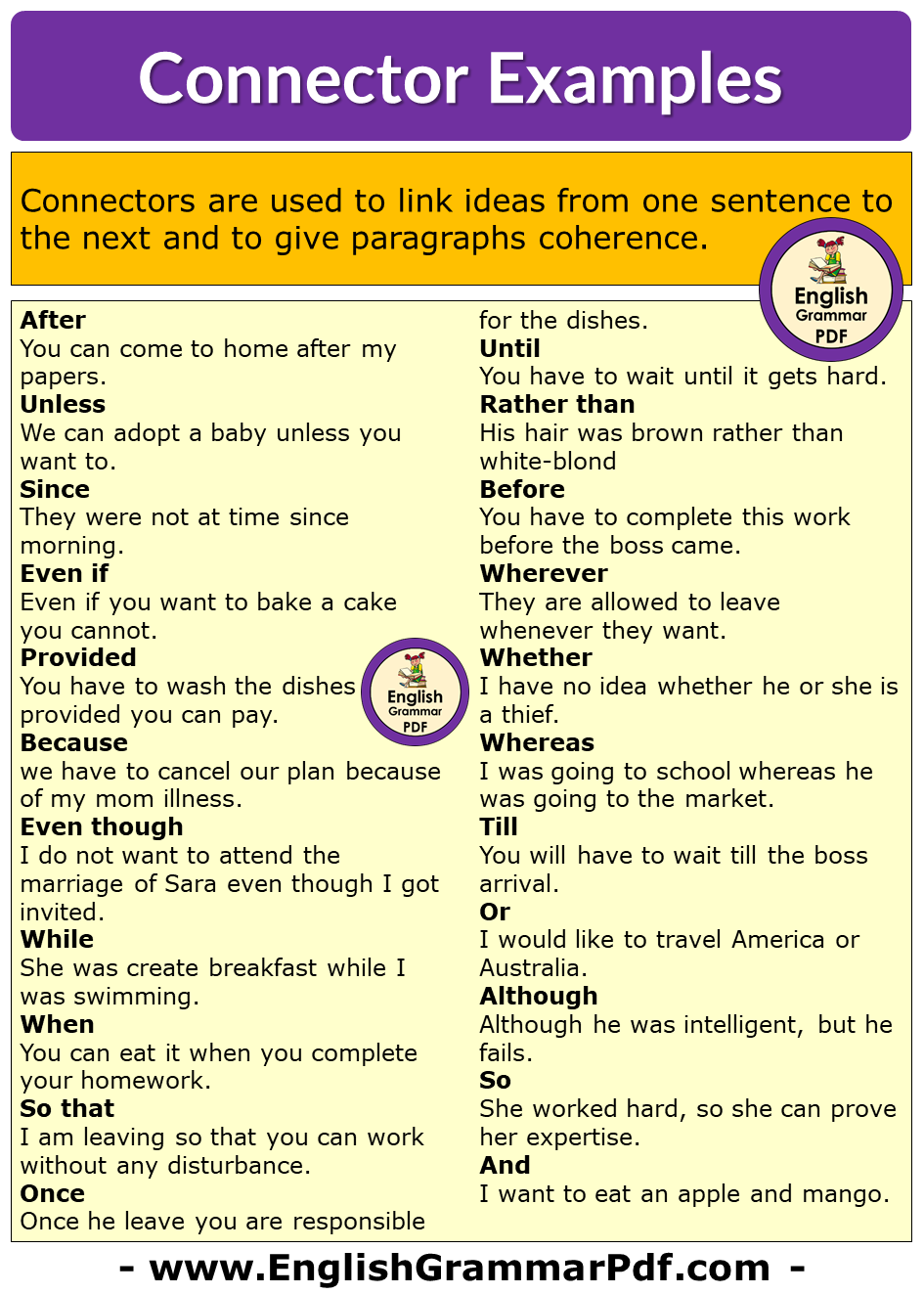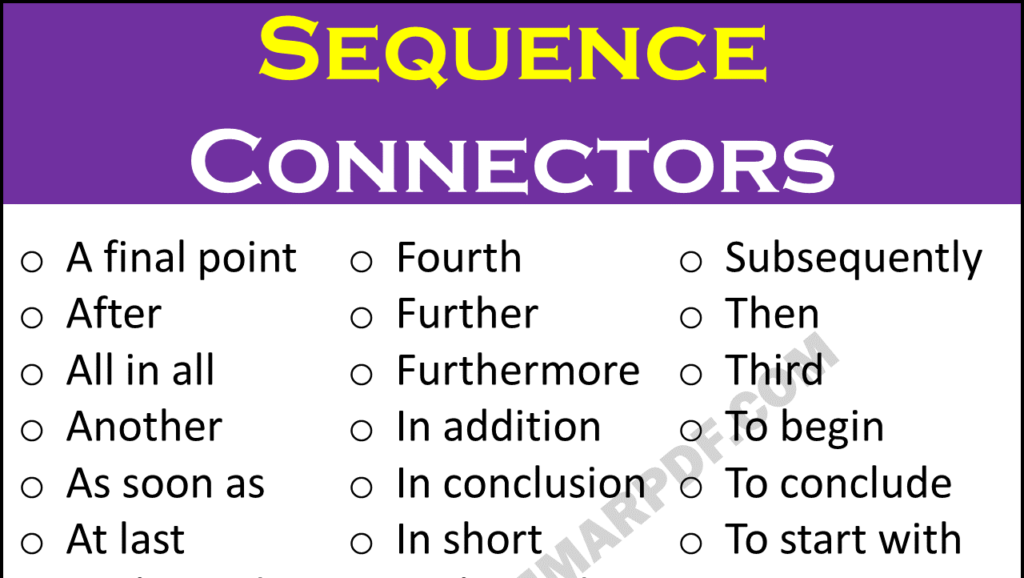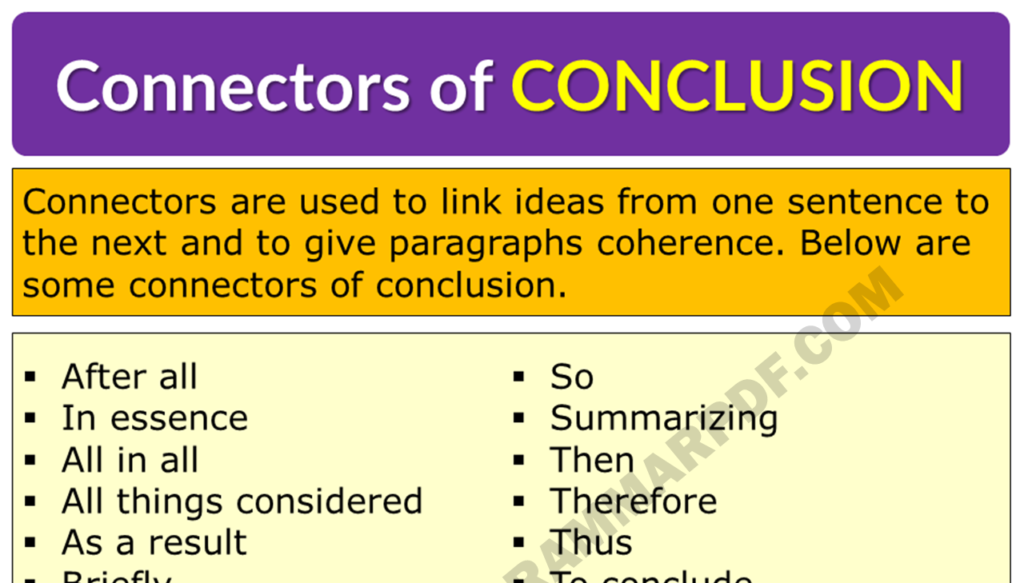Hello, friends! Do you want to make your English smoother and better? Connectors are magic words for this! They are like bridges in sentences. Today, we’ll learn about these helpful connectors with easy examples. And guess what? You can download this lesson as a PDF at the end of this page. Let’s start!
Definition of Connectors
Connectors, in the context of language and grammar, are words or phrases used to link together different parts of a sentence or different sentences. They help in making the communication clearer and more coherent by showing the relationship between ideas. There are several types of connectors, including:
1. Coordinating Connectors:
-
- Function: They connect elements of equal grammatical rank, such as words with words, phrases with phrases, or clauses with clauses.
- Common Examples: “and”, “but”, “for”, “nor”, “or”, “so”, “yet”.
- Usage Example:
- “I wanted to go for a walk, but it started raining.”
- Here, “but” is used to join two independent clauses, showing a contrast.
2. Subordinating Connectors:
-
- Function: These connectors are used to join an independent clause and a dependent clause. The dependent clause cannot stand alone and the connector shows a relationship like cause and effect, contrast, or time.
- Common Examples: “although”, “because”, “if”, “since”, “though”, “whereas”, “while”.
- Usage Example:
- “I went out even though it was raining.”
- “Though” introduces a dependent clause, providing a contrast to the main clause.
3. Transitional Connectors or Conjunctions:
-
- Function: These connectors are used to provide a smooth transition between ideas in sentences and paragraphs. They can indicate addition, contrast, sequence, summary, or cause and effect.
- Common Examples: “however”, “moreover”, “therefore”, “consequently”, “furthermore”, “nevertheless”, “thus”.
- Usage Example:
- “It was raining heavily; therefore, the event was postponed.”
- “Therefore” is used to show cause and effect between two independent clauses.
4. Correlative Connectors:
-
- Function: These connectors are used in pairs to join various sentence elements that are grammatically equal. They add emphasis and relation between the paired elements.
- Common Examples: “either…or”, “neither…nor”, “not only…but also”, “both…and”.
- Usage Example:
- “She will either go for a hike or stay home to read.”
- “Either…or” is used to link two possibilities of equal importance.
Connectors List and Example Sentences
- Because – Shows a reason for something.
- Example: “I stayed home because it was raining.”
- Therefore – Indicates a consequence or result.
- Example: “He was late, therefore he missed the meeting.”
- However – Introduces a contrasting idea.
- Example: “I wanted to buy the dress; however, it was too expensive.”
- In addition – Adds information to what has been said.
- Example: “She plays the piano, and in addition, she sings.”
- Moreover – Adds further emphasis or information.
- Example: “The plan is risky; moreover, it’s expensive.”
- Consequently – Shows a direct result.
- Example: “He didn’t study, consequently, he failed the exam.”
- Nevertheless – Indicates a contrast despite something.
- Example: “It was raining, nevertheless, we went hiking.”
- Thus – Indicates a conclusion or result.
- Example: “She ignored the advice, thus she made a big mistake.”
- Firstly – Starts a list or sequence of points.
- Example: “Firstly, we must consider the costs.”
- Secondly – Continues a sequence of points.
- Example: “Secondly, the approach must be practical.”
- Finally – Concludes a list or sequence of points.
- Example: “Finally, we reached an agreement.”
- Meanwhile – Shows what is happening at the same time.
- Example: “I am studying; meanwhile, my brother is playing.”
- Subsequently – Indicates the next step or stage.
- Example: “He passed his driving test, subsequently, he bought a car.”
- As a result – Shows the outcome of a situation.
- Example: “He worked hard, as a result, he was promoted.”
- Due to – Indicates a cause.
- Example: “Due to heavy rain, the match was postponed.”
- As – Indicates a reason, similar to ‘because’.
- Example: “He couldn’t come, as he was sick.”
- So – Shows a result or effect.
- Example: “It was cold, so I wore a jacket.”
- Yet – Introduces a contrast or exception.
- Example: “She’s rich, yet she lives modestly.”
- Since – Indicates a time from the past until now, or a reason.
- Example: “Since it’s raining, we will stay indoors.”
- While – Shows a contrast or indicates simultaneous actions.
- Example: “While I understand your point, I disagree.”
- Although – Indicates a contrast or exception.
- Example: “Although it was raining, we went out.”
- If – Introduces a conditional clause.
- Example: “If you study hard, you’ll pass the exam.”
- Unless – Indicates a condition where something will or won’t happen.
- Example: “We will be late unless we leave now.”
- Because of – Indicates a reason, similar to ‘because’.
- Example: “We were late because of the traffic.”
- In case – Used to refer to taking action for a possible future situation.
- Example: “Take an umbrella, in case it rains.”
- Before – Indicates an action that happens earlier than another.
- Example: “Finish your homework before you watch TV.”
- After – Indicates an action that happens later than another.
- Example: “We went out after dinner.”
- During – Indicates something that happens within a particular period.
- Example: “No talking during the presentation.”
- When – Indicates a specific time something happens.
- Example: “When I arrived, everyone was waiting.”
- Whenever – Indicates any time or every time something happens.
- Example: “You can call me whenever you need help.”
- Till – Indicates a time up until a certain point.
- Example: “Wait here till I return.”
- Until – Similar to ’till’, indicating a continuation up to a certain time.
- Example: “I can’t relax until the work is done.”
- By the time – Indicates an action that will be completed before another.
- Example: “By the time he arrived, we had finished eating.”
- As soon as – Indicates immediate action after something.
- Example: “I will call you as soon as I arrive.”
- Now that – Indicates a new situation that affects future actions.
- Example: “Now that I’m here, we can start.”
- Once – Indicates when something happens one time or at the moment it begins.
- Example: “Once you apologize, we can move on.”
- As long as – Indicates a condition for something to happen.
- Example: “You can stay as long as you keep quiet.”
- As well as – Used to add an additional point or idea.
- Example: “She sings as well as she plays piano.”
- Not only… but also – Used to add an extra piece of information of equal importance.
- Example: “He is not only smart but also kind.”
- Either… or – Indicates a choice between two alternatives.
- Example: “You can choose either coffee or tea.”
- Neither… nor – Used to deny two alternatives simultaneously.
- Example: “Neither the blue shirt nor the red one fits me.”
- Both… and – Used to emphasize two things together.
- Example: “She speaks both English and French fluently.”
- Rather than – Indicates a preference for one thing over another.
- Example: “I prefer walking rather than driving.”
- Such as – Used to give specific examples.
- Example: “I love fruits, such as apples and bananas.”
- Including – Used to add something as part of a larger group.
- Example: “Many countries, including France, were represented.”
- For example – Used to introduce a specific example or instance.
- Example: “There are many hobbies you can try, for example, knitting or painting.”
- To illustrate – Used to explain or clarify by giving an example.
- Example: “To illustrate, let’s look at a case study.”
- In other words – Used to rephrase or explain something more clearly.
- Example: “He’s frugal, in other words, he doesn’t like spending much.”
- Namely – Used to specify something clearly.
- Example: “She likes tropical fruits, namely mangoes and pineapples.”
- In short – Used to summarize or conclude briefly.
- Example: “In short, it was a great success.”

Related:
- Connectors of Cause & Effect List
- Connectors of Opinion List
- Connectors of Conclusion List
- Sequence Connectors List
Download this Lesson in PDF


